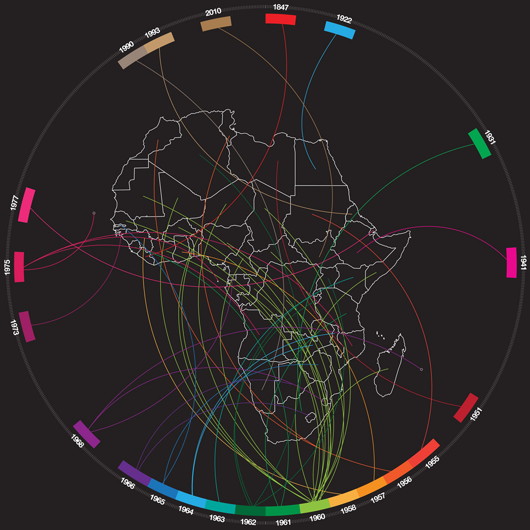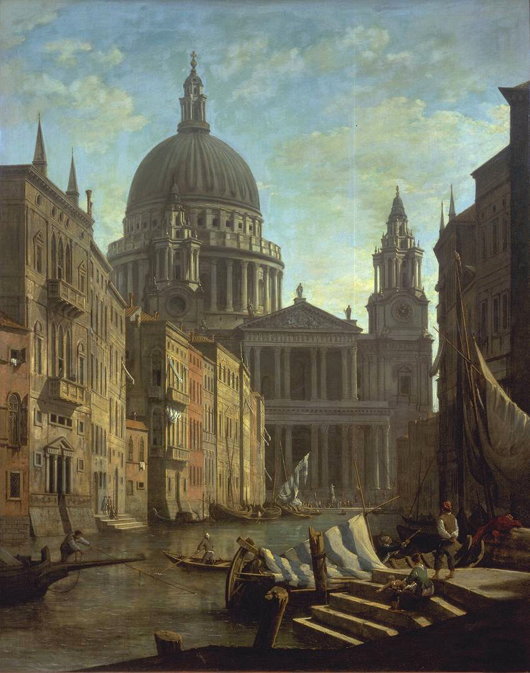2012 August
About Andrew Cusack
 Writer, web designer, etc.; born in New York; educated in Argentina, Scotland, and South Africa; now based in London.
Writer, web designer, etc.; born in New York; educated in Argentina, Scotland, and South Africa; now based in London. read more
News
Blogs
Reviews & Periodicals
Arts & Design
World
France
Mitteleuropa
Knickerbockers
Argentina
The Levant
Africa
Cape of Good Hope
Netherlands
Scandinavia
Québec
India
Muscovy
Germany
Academica
Arab Newspapers
Having recently made my first venture into the Middle East, I thought I’d provide a brief overview of the pan-Arab newspapers that are read by exiles, businessmen, and intellectuals in Arabia and the diaspora.
The Impetuosity of Youth
From the Flickr feed of South Africa’s Etienne du Plessis:
These pictures were taken 2 October 1964: I was the pilot [writes Quentin Mouton]. The pictures are original and not ‘touched up’. The ‘Pongos’ (Army types) were on a route march from Langebaan by the sea to Saldanha. The previous night in the pub one of them had said: “Julle dink julle kan laag vlieg maar julle sal my nooit laat lê nie!” (You think you can fly low, but you will never make me hit the deck). Hullo!!!
I went to look for them on the beach in the morning and was alone for the one picture. I was pulling up to avoid them. In the afternoon I had a formation with me and you can see the other a/c behind me. (piloted by van Zyl, Kempen, and Perold).
A friend by the name of Leon Schnetler (one of the pongos) took the pics. The guy that said “Jy sal my nie laat lê nie!” said afterwards that he was saying to himself as I approached: “Ek sal nie lê nie, ek sal nie lê nie” (I wont go down, I wont go down) and when I had passed he found himself flat on the ground.
Memories from the past.

African Independence


The nifty ‘Tumblr’ site Afrographique, which Africa-related facts and statistics in a visually appealing and accessible way, created a handy chart of all the countries of Africa and the years they became independent. The chart correctly gives Zimbabwe’s date of independence as 1965, even though it had a brief return to colonial status for a few months in 1979-1980. Yet it lists Ethiopia’s “independence” year as 1941, despite the fact that Ethiopia has arguably been independent forever.
The Empire of Ethiopia was founded in 1137 with the ascent of the Zagwe dynasty (responsible for the country’s world-famous rock-hewn churches), and while it was occupied by the Kingdom of Italy (whose monarch usurped the title ‘Emperor of Abyssinia’) from 1936 to 1941 with a continued insurgency and a lack of abdication by the legitimate emperor, Haile Selassie, there’s a strong case that Ethiopia retained her independence throughout but merely suffered a temporary foreign occupation.
Despite this arguable discrepancy it’s not nearly so bad as Africa Report, which published a chart claiming that South Africa gained its independence in 1994. Pray tell, what colonial power ran South Africa before 1994? South Africa was unified and gained dominion status in 1910, and Afrographique goes for the much safer independence date of 1931 when the Statute of Westminster was adopted asserting the sovereignty of the dominions of the British Empire. Some Afrikaners claim South Africa did not become independent until the Republic was declared in 1961, but this is neither legally nor constitutionally the case as the country as an internationally recognised sovereign independent nation merely changed its form of government from a monarchy to a republic.
Afrographique has a number of other interesting posts, including African Nobel Prize winners (nine of them South African, across medicine, peace, and literature) and the ten richest Africans (fellow Matie Johann Rupert is #4).
Marlow’s St Paul’s Capriccio

c. 1795; oil on canvas, 60 x 41 in.; London, Tate Gallery
The view of St Paul’s Cathedral as if it had been completed according to the original plans of Wren and with Hawksmoor’s baptistry (which I posted yesterday) reminded me of this capriccio by William Marlow. And then this in turn recalled my 2005 post If London Were Like Venice.
The Perfect Place for Coffee
I’m not sure when I became the sort of person who lounges around drinking coffee. I was never much of a fan of coffee, and remain deeply suspicious of it (hence, for example, refusing to become a daily coffee drinker — very dangerous!). I suppose it was on pilgrimage to Rome in my fourth year of university when I was introduced to the blessed simplicity of cappuccino e cornetto for breakfast; a total riposte to the traditional Scottish morning meals of my habit up ’til then.
After Rome, my daily habit became to rise around 9 o’clock, complete one’s morning toilette, head out around 10 to pick up Le Figaro and maybe The Scotsman if I was in the mood, and then a sugar doughring from Fisher & Donaldson, after which I would sit in Taste, the minuscule place on North St at the top of Murray Park which serves the best coffee in the Royal Burgh, for about an hour or so reading and staring out the window episodically while nursing a cappuccino. This was an exceptionally enjoyable routine, brought to an abrupt end by the cruel realities of the forward movement of time and finishing one’s degree.
Whether rightly or not, I’ve no idea, the concept of dwelling over coffee seems more a habit north of the Alps than south. The quick coffee seems more Italian, and more than once I stopped into Taste with Stefano or others for an unponderous espresso when an afternoon pick-me-up was deemed amenable.
But for the most part, I prefer to rest with a bit of coffee, and read something interesting. Last summer I found myself with a lot of free time in London and spent the greater portion of it in a curious little café-bar not open to the general public reading long historical articles off of JSTOR on such fascinating subjects as the origins of Argentine militarism or the unexpected nineteenth-century German Catholic revival as well as translations of the indispensable Pierre Manent printed in Modern Age.
There was barely ever anyone there in high summer except the two barstaff, myself, and a haggard journalist in late middle age sitting at the bar nursing his first pint of the day. I still go there from time to time, and recently enjoyed sitting there reading Perry Anderson’s trilogy of insightful, deep, and informative articles on India from the London Review of Books (‘Gandhi Centre Stage’, LRB 5 July 2012; ‘Why Partition?’, LRB 19 July 2012; ‘After Nehru’ LRB 2 August 2012).
There is a Pret near my flat where the staff are very nice, but I remember one Saturday morning when I actually stirred from my slumber and fancied catching up with the weekend Irish Independent. I happened to sit next to an awkward Indian computer engineer on a blind date with a Polish girl lacking in self-esteem. I found I could barely get any reading done with them nextdoor and instead relayed the essence of their conversation to a pretty girl sitting in bed in Oxford reading Glamour, who relayed back her own thoughts. The pros and cons of your average Pret come to mind and encourage me to explore what the perfect place for coffee would be like.
First, a coffee place should be mildly popular. There ought to be enough people milling around that it feels lived-in but not so many that you can rarely find a place to sit. The staff must be highly competent in their coffee making, and preferably either young, pretty, Italian, and female or else French chaps with a slightly haughty demeanour until the third or fourth time they see you. We will also accept vaguely hippie/alt-ish characters mostly from the Continent or occasionally the Antipodes. And Inez. (Inez, you can work at any coffee place approaching perfection).
Counter space! This cannot be emphasised enough: there ought to be counter space. I dislike when places have large, tall, bulky displays of the variety of pastries and such on offer and then have a tiny little open space to give your order and pay, etc. Broad counter spaces relay a certain openness and give the impression that the staff behind the bar are accessible. By all means display your delectamenta but you should aim for balance and harmony in your serving area.
There ought to be counter seating as well. Lots of coffee places put this at the window, which is acceptable, but as I like to sit in a large comfy chair and stare out the window, this is impeded by window counter seating, and thus I am mostly against it. And windows: we must have windows, preferably big giant ones with a single plane of glass looking out on a somewhat busy street, or even better a small public square.
Seating is one of the most important aspects. Hard or soft? High tables or low? In a word: both. There ought to be more café-style seats and round tables for when there’s three or four of you gathering, but also soft big comfy chairs for when that feels more appropriate. Different coffee-imbibing situations require different kinds of seating, and the perfect place for coffee should offer both.
I’ve yet to find the perfect place for coffee in London. I was quite fond of the Caffè Nero on Warwick Way in Pimlico with its huge glass panels that open up on summer days, but now that I no longer live in Pimlico it has ceased to be useful or easy to get to. As chains go, I tend to err on the side of Pret, perhaps merely out of habit. Whatever you do, just don’t go to Starbucks. Have some dignity and self-regard.
And if you do find the perfect place for coffee, do let the rest of us know.
Carl Laubin’s Architectural Fantasies
While the subjects of his works are varied, Carl Laubin has become best known for his architectural paintings. Born in New York in 1947, he veered into architectural painting when he was taken on by the London office of Richard Dixon — now part of Dixon Jones, the firm responsible for, among other projects, the Royal Opera House and the redesign of Exhibition Road. With an eye for detail, he has completed capriccios displaying the total built corpus of Hawksmoor, Cockerell, and, most recently, Vanbrugh, while the National Trust also commissioned him to paint a capriccio of all the houses currently within their care.
More of his work can be viewed at the website of Plus One Gallery, and a book of his paintings has been published by Philip Wilson. (more…)
The UN at Quebec
IN 1943, THE BRITISH, Canadian, and American governments descended upon the city of Quebec, capital of la vieille province, for an intergovernmental conference to plan the invasion of France — surely one of the greatest military tasks ever undertaken in the modern era. The site proved auspicious due to a peculiar combination of factors: Quebec City enjoys a certain European cachet but with both the geographic safety of North America and the more spacious accommodation usual to that continent. The three governments held a second conference there in 1944, and in 1945 the International Labour Organisation met in the city, followed a few months later by the Food & Agriculture Organisation of the nascent United Nations.
With this track record of indisputable experience, the ville de Québec, lead by its mayor Lucien Borne, put in a bid to be the permanent seat of the United Nations Organisation. (more…)
Ireland needs an undeniably world-class university
NOT A SINGLE Irish university made it into the top 100 of the Times Higher Education World University Rankings this year, but reviving an old proposal might give Ireland more global clout in the academic sphere. While all rankings systems are on some level arbitrary, the THE takes into account the views of over 17,000 academics across the planet and gives us an insight into how institutions — and by extension their host countries — are perceived not only in academia but also in the perhaps more lucrative field of research and development.
Being pushed out of the top 100 doesn’t necessarily indicate that higher education in Ireland is in any crisis; it could merely reflect the comparative rise of other institutions in countries which are beginning to appreciate the value of academic research and institutional prestige. But a country shouldn’t rest on its laurels, and it’s worth asking: Is Ireland missing an opportunity to have a university of unquestionable world-class status?
Reflecting on the 2012 THE rankings, political commentator Richard Waghorne suggested via Twitter that it is high time that University College Dublin, Trinity, and Dublin City University were amalgamated into the University of Dublin. This is an idea with a long heritage which, even if it is to be rejected, needs to be considered seriously. (more…)
Search
Instagram: @andcusack
Click here for my Instagram photos.Most Recent Posts
- Burns Tower April 19, 2024
- Patrick in Parliament March 18, 2024
- Articles of Note: 13 March 2024 March 13, 2024
- Cambridge March 9, 2024
- Taken on Trust March 4, 2024
Most Recent Comments
Book Wishlist
Monthly Archives
Categories


